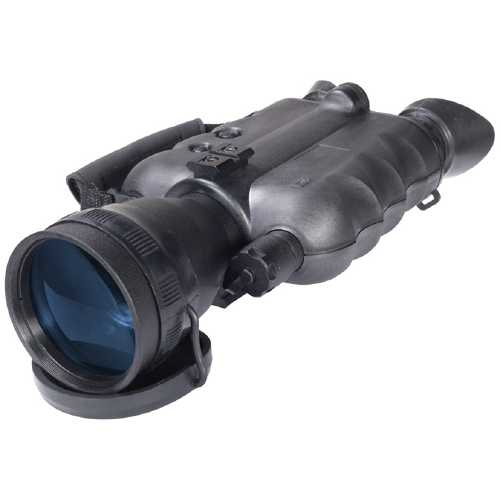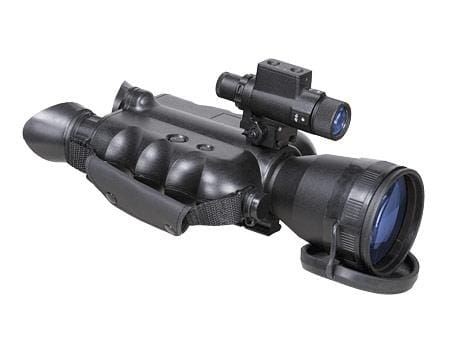ATN makes thermal and night vision devices and weapon sights. RF offered me an opportunity to play around with one of their bi-oculars—one objective in to two eyepieces—the Voyager 5-2, and I couldn’t say no. The “5” stands for 5x magnification and the “2” tells you that the Voyager sports Gen 2 image intensifier tubes. If you’ve never used one, night vision devices intensify ambient visible and infrared light within a scene. With any night vision device, the first spec to look for is the generation number of the light intensifier. The generation determines two things: the quality of the intensified image and cost . . .
There are four different generations and all are still available on the market. While increasing the quality of the image is always a good thing, the catch is that each incremental generational jump approximately doubles the price.
ATN classifies the Voyager 5-2 as a medium range device and street price is about $2000, plus or minus a Benjamin. Its digital user controls include automatic brightness adjustment, a bright light cut-off and a low battery indicator. The Voyager will focus from 5 meters out to infinity and it has a proximity sensor which identifies the user’s intention to look through the bi-ocular. That means that when you raise the bi-ocular up to your eyes, it automatically turns on. Lower them and it turns itself off – pretty slick.
The Voyager’s body is made of plastic, but it’s very sturdy and well built. A hand strap increases comfort and helps protect against butterfingers. The unit can also be mounted on a tripod. The lens cap is captive, so when removed, it remains on the device to keep mindless folk like myself from losing it. I can’t even tell you how many camera lens caps I’ve lost.
And the lens cap on a night vision device is very important as having the device turned on in daylight can damage the intensifier tube. The Voyager’s cap has a 1/2-inch hole in its center to reduce the amount of light transmitted if needed when viewing a more highly illuminated scene.
The first thing I did to test this thing out was to take the Voyager down into my basement, turn off all the lights and see what I could see. And I saw, in a word, nothing, zilch, nada. OK…so that’s three words. Whatever, the reason I couldn’t see my furnace and water heater was because night vision intensifies existing light. Since all the lights were off and I have no windows in my basement, there was no existing light down there to be magnified.
So, I powered up the infrared flashlight that’s included with the Voyager and voila, my basement lit up like a menorah on the 8th night. The included infrared light, which ATN calls an illuminator, can be mounted on top of the unit and is spec’d to reach 100 yards. Naturally I had to try it out to see. Turns out that truth in advertising prevails, and it really does reach out to about 100 yards.
Back inside, I doused the lights and closed the door to my office. The room was lit by only the power lights on my telephone and fax machine—yes, I still use one of those things — and I could see everything, clear as day. Very cool.
ATN states the Voyager can be used for boating, camping, home security and wildlife observation. I would certainly add hunting to that list and let’s not forget tracking down those ever-present zombies. I can’t even believe I used that word.
Specifications:
Magnification: 5X
Field of View: 9.5°
Infrared Illuminator: Detachable IR450
Power supply: 1 x 1.5V AA type or 1 x 3V CR123A battery
Battery life: 60 hours (3V) / 30 hours (1.5V)
Size: 254x140x78 mm/10″x5.5″x3.1″
Weight: 1.3 kg / 2.9 lbs
MSRP: $2100 (about $2000 street)
Ratings (out of five stars):
Build Quality: * * * * *
The Voyager is nothing if not sturdy
Picture Quality: * * and * * * * *
It gets two stars because it’s a Gen 2, so it’s image isn’t up to the current state of the art. But as a Gen 2 optic, it does what it’s made to do as well as you’d want it to.
Ease of Use: * * * * *
Simple interface with nice automatic features. Pretty much all you’d want.
Overall: * * * * *
Great for what it is, but spending more and getting a higher generation optic will get you a much better image.







How is the depth perception with it?? The AN-PVS4&5 series of NVD’s we used in the Army were pretty good except for the problem of a lack of depth perception.
There’s only one imaging tube, you’re seeing the same picture in each eye. No depth perception at all. You need a genuinely binocular set for that.
Haven’t used any since I got out of the military. The bino style we had really sucked on a super dark cloudy might trying to walk along below the ridge line of a mountain and see where the hell you were trying to walk without stepping off in a big hole!!!
Especially when one of the newbies got bored and wanted to play with the IR mode or flip on a flashlight to see how long he had been walking.
I’ve got a Gen1 monocular, which is only slightly better than letting your eyes adapt to the dark. I’m disappointed that Gen2 devices are still so costly. They’ve been militarily obsolete (except in Haiti or Niger) for fifteen years.
I don’t understand how a device that uses a concept discovered by Einstein over 100 years ago still costs so much when every other electronic device, esp. cameras, are so much cheaper now.
really thought the prices on these would have come down in the last decade or so. I would really like to have a set, but geeze 2 grand will buy lots of ammo.
More like the Voyeur 5-2. Great Christmas gift for that peeping Tom on your list.
I’ve got one of their older Gen 2 scopes. I would assess it as roughly the equivalent of a PVS4, thought it is substantially lighter.
IR illuminator is the “Here I am!” of the military world.
More like the” Hey Guys!! Over here!!” type of silliness. We would have our team electrical experts disable the IR on our PVS’s so no one would accidentally turn them on while switching the unit on or off.
Want.
An old roommate of mine pre-ordered the Special Super Elite Epic HSLD Operator Edition of CoD 4: MW2: OMG: WTF a few years ago. For, I want to say, $160, he got a $60 game… and a set of actual NVGs. Oh, and a stupid plastic stand in the shape of one of the stupid characters from the equally stupid single player campaign. Anyway, I think it was 1st Gen and it was made of plastic, but they were the cheapest set of functioning NVGs I think I have ever seen. Barely trusted them for a walk through the house much less a romp through the forest or worse, but brighten the world, they did. Even had an IR lamp. They were pretty damn cool. Made me lust for MOAR. Too bad my bank account is frigid at that thought.
Not as frigid as my wife’s reaction should I inform her that I’d dropped $2K on NVGs. Even worse if she found out I’d spent that much on 2nd-gen tech.
My fiancée’s reaction would be shock, dismay, and then delight because then SHE’D want $2k to spend on toys. :X
Comments are closed.